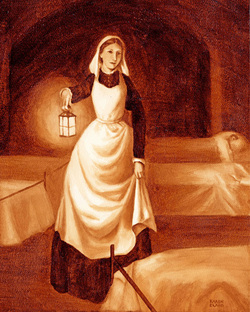Who was Nightingale?
Florence Nightingale (12 May 1820 – 13 August 1910) was a celebrated English nurse, writer and statistician. A Christian, Nightingale believed that God had called her to be a nurse. She came to prominence for her pioneering work in nursing during the Crimean War, where she tended to wounded soldiers. She was called "The Lady with the Lamp" after her habit of making rounds at night.
Early life:
The name ‘Florence’ got bestowed upon her after the place of her birth. As a child Florence was very close to her father, William Florence Nightingale. William treated Florence as his friend and took responsibility for her education and imparted the knowledge on Greek, Latin, French, German, Italian, history, philosophy and mathematics to Florence. Florence was a strong-willed woman who rebelled against the prejudice view about the role of a woman of her status, which was to become an obedient wife. Inspired by what she took to be a call from God in February 1837 at Embley Park, Florence made a commitment to become a nurse, a career of poor reputation. She was interested in serving the poor that made her interested in looking after those who were ill. She visited many hospitals in and around the country to investigate about the possible opportunities for women there. Florence with a strong sense to care for the poor, announced her decision to enter nursing in the year 1844. She worked hard to educate herself in the art and science of nursing, fighting against all the restrictive societal code for affluent young English women.
Florence Nightingale (12 May 1820 – 13 August 1910) was a celebrated English nurse, writer and statistician. A Christian, Nightingale believed that God had called her to be a nurse. She came to prominence for her pioneering work in nursing during the Crimean War, where she tended to wounded soldiers. She was called "The Lady with the Lamp" after her habit of making rounds at night.
Early life:
The name ‘Florence’ got bestowed upon her after the place of her birth. As a child Florence was very close to her father, William Florence Nightingale. William treated Florence as his friend and took responsibility for her education and imparted the knowledge on Greek, Latin, French, German, Italian, history, philosophy and mathematics to Florence. Florence was a strong-willed woman who rebelled against the prejudice view about the role of a woman of her status, which was to become an obedient wife. Inspired by what she took to be a call from God in February 1837 at Embley Park, Florence made a commitment to become a nurse, a career of poor reputation. She was interested in serving the poor that made her interested in looking after those who were ill. She visited many hospitals in and around the country to investigate about the possible opportunities for women there. Florence with a strong sense to care for the poor, announced her decision to enter nursing in the year 1844. She worked hard to educate herself in the art and science of nursing, fighting against all the restrictive societal code for affluent young English women.
Why Nightingale was called ‘The lady with the lamp’
When the Crimean war started between England, France &turkey with Russia, many soldiers were wounded. The soldiers of France wear getting proper care but the soldiers of England were on the worst situation without proper care. When she came to know about this she went to Scutari hospital with 38 more nurses. She arranged things ,brought all necessary things took proper care of all wounded soldiers .She helped or served or worked for 20 to 22 hours a day . Even at the night, she used to go to see the patients by caring lamp on her hand. That's why all the soldiers called her as lady with the Lamp. Her care and devotion reduce the death rate by nearly 42%.
Death:
On 13 August 1910, at the age of 90, she died peacefully in her sleep in her room at 10 South Street, Park Lane The offer of burial in Westminster Abbey was declined by her relatives, and she is buried in the graveyard at St. Margaret Church in East Wellow, Hampshire.
When the Crimean war started between England, France &turkey with Russia, many soldiers were wounded. The soldiers of France wear getting proper care but the soldiers of England were on the worst situation without proper care. When she came to know about this she went to Scutari hospital with 38 more nurses. She arranged things ,brought all necessary things took proper care of all wounded soldiers .She helped or served or worked for 20 to 22 hours a day . Even at the night, she used to go to see the patients by caring lamp on her hand. That's why all the soldiers called her as lady with the Lamp. Her care and devotion reduce the death rate by nearly 42%.
Death:
On 13 August 1910, at the age of 90, she died peacefully in her sleep in her room at 10 South Street, Park Lane The offer of burial in Westminster Abbey was declined by her relatives, and she is buried in the graveyard at St. Margaret Church in East Wellow, Hampshire.
